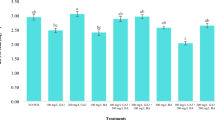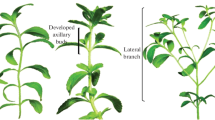Abstract
Calendula officinalis L. bears a short main axis and branches of several orders. The upper axillary branches grow vigorously whereas the lower branches remain arrested at different levels. Foliar application of gibberellic acid (GA3) stimulated the elongation of the main shoot and of the upper few primary axillary branches (PAB’s). The length of the main axis nearly doubled 10 days after application. The endogenous level of GA3 is probably sub-optimal, since external application enhances stem growth. However, treatment caused varying degrees of stimulation of the arrested branches. Whereas all the concentration of GA3 were equally effective in promoting the growth of the first six primary axillary branches after 60 days of application, in plants treated with 500 ppm, the lower primary axillary branches failed to develop. Since the lower axillaries remained inhibited, it is presumed that 500 ppm of GA3 is supra-optimal. At 100 and 250 ppm, however, the growth of the arrested branches at the base was significantly increased.
Thirty days after application, GA3 promoted growth and augmented the number of secondary axillary branches. Curiously at 100 ppm GA3 markedly inhibited the length of the secondary axillary branches of PAB3 to PAB6.
These studies show that a complex mechanism of apical dominance operates inCalendula officinalis.
Similar content being viewed by others

References
Bernier G, Bronchart R, Jacqmard A and Sylvestre G 1967 Acid gibberéllique et morphogériése caulinaire;Bull. Soc. R. Bot. Belg. 100 51–71
Brian P W 1961 The gibberellins: A new group of plant hormones;Sci. Prog. London XLIV 1–15
Brian P W 1966 The gibberellins as hormones;Int. Rev. Cytol. 19 229–266
Brian P W and Hemming H G 1955 The effect of GA3 on shoot growth of pea seedlings;Physiologia Pl.8 669–681
Catalano M and Hill T A 1969 Interaction between gibberellic acid and kinetin in overcoming apical dominance, natural and induced by IAA, in tomato (Lycopersicum esculentum Mill. cultivarpotentate);Nature (London) 222 985–986
Cutter E G 1972The dynamics of meristem cell populations; eds M M Miller and C C Kuehnert (New York: Plenum Press) pp. 51–73
Federer W T 1955Experimental design: theory and application (New York, Chicago: MacMillan Co.)
Jacobs W P and Case D B 1965 Auxin transport, gibberellin and apical dominance;Science 148 1729–1731
Jones R L 1973 Gibberellins: their physiological role;A. Rev. Pl. Physiol. 24 571–598
Jones R L and Phillips I D J 1966 Organs of gibberellin synthesis in light-grown sunflower plants;PL Physiol. 41 1381–1386
Kato J 1958 Studies on the physiological effect of gibberellin. 1. On the interaction of gibberellin with auxins and growth inhibitors;Physiologia Pl. 11 10–15
Krishnamoorthy H N (ed) 1975Gibberellins and plant growth (New Delhi: Wiley Eastern)
Lang A 1956 Stem elongation in a rosette plant induced by gibberellic acid;Naturwissenschaften 43 257–258
Lang A 1970 Gibberellins; Structure and metabolism;A. Rev. Pl. Physiol. 21 537–570
Lang A, Sandoval J A and Bedri A 1957 Induction of bolting and flowering inHyoscyamus andSamolus by a gibberellin-like material from a seed plant;Proc. Natl. Acad. Sci., U.S.A. 43 960–964
Musgrave A, Kays S E and Kende H 1969 In vivo binding of radioactive gibberellins in dwarf pea shoots;Planta 89 165–177
Nakumura E 1965 Studies of the branching inPisum sativum L. Special report of the laboratory of horticulture, Shiga Agricultural College, Japan
Nanda K K, Dhindsa R S and Bindra B 1967 Effect of gibberellic acid and photoperiod on extension growth of soybean;Indian J. PL Physiol. 10 183–195
Narasimham P 1972 Interaction effects of gibberellic acid, indoleacetic acid, and kinetin on the growth and development ofCapsicum sp. seedlings, in relation to apical dominance;Ann. Physiol. Vég. Univ. Brunx. 17 1–27
Paleg L G 1965 Physiological effects of gibberellins;A. Rev. Pl. Physiol. 16 291–322
Peterson R L and Yeung E C 1972 Effect of two gibberellins on species of the rosette plantHiera. cium;Bot. Gaz. 133 190–198
Pharis R P, Kuo Ching-Chi and Glenn J L 1970 Gibberellin, a primary determinant in the expression of apical dominance, apical control and geotropic movement of conifer shoots;Plant Growth Substances ed D J Carr (Berlin: Springer-Verlag) pp. 441–448
Phillips I D J 1969 Apical dominance inThe physiology of plant growth and development ed M B Wilkins (London: McGraw-Hill) pp. 161–202
Phillips I D J 1975 Apical dominance;A. Rev. PL Physiol. 26 341–367
Phinney B O 1957 Growth response of single-gene dwarf mutants in maize to gibberellic acid;Proc. Natl. Acad. Sci., U.S.A. 42 185–189
Sachs R M 1965 Stem elongation;A. Rev. PI. Physiol. 16 73–96
Sachs R M 1968 Control of intercalary growth in the scape ofGerbera by auxin and gibberellic acid;Am. J. Bot. 55 62–68
Sachs R M, Bretz C F and Lang A 1959-Shoot histogenesis: The early effects of gibberellin upon stem elongation in two rosette plants;Am. J. Bot. 46 376–384
Scott T K, Case D B and Jacobs W P 1967 Auxin-gibberellin interaction in apical dominance;Pl. Physiol. 42 1329–1333
Snedecor C W 1946Statistical methods (Ames: Iowa State College Press)
Söding H 1926 Uber den Einfluss der Junge Infloreszenz auf das Wachstum ihres Schaftes;Jb. Wiss. Bot. 65 511–535
Stant M Y 1959 Some growth responses to gibberellic acid;J. Linn. Soc. Bot. LXI 249–250
Thomas T H 1972 The distribution, of hormones in relation to apical dominance in Brussel sprouts (Brassica oleracea var.gemmifera) plants;J. Exp. Bot. 23 294–301
Tucker D J 1976 Endogenous growth regulators in relation to side shoot development in the tomatoNew Phytol. 77 561–568
Tucker D J and Mansfield T A 1972 Effects of light quality on apical dominance inXanthium strumarium and associated changes in endogenous levels of abscisic acid and cytokinins;Planta 102 140–151
Tucker D J and Mansfield T A 1973 Apical dominance inXanthium strumarium;J. Exp. Bot. 24 731–740
Wickson M and Thimann K V 1958 The antagonism of auxin and kinetin in apical dominance;Physiologia pl 11 62–74
Author information
Authors and Affiliations
Rights and permissions
About this article
Cite this article
Mohan Ram, H.Y., Mehta, U. Effect of gibberellic acid on the growth of main shoot and axillary branches inCalendula officinalis . Proc. Indian Acad. Sci. 87, 255–270 (1978). https://doi.org/10.1007/BF03048155
Received:
Issue Date:
DOI: https://doi.org/10.1007/BF03048155



